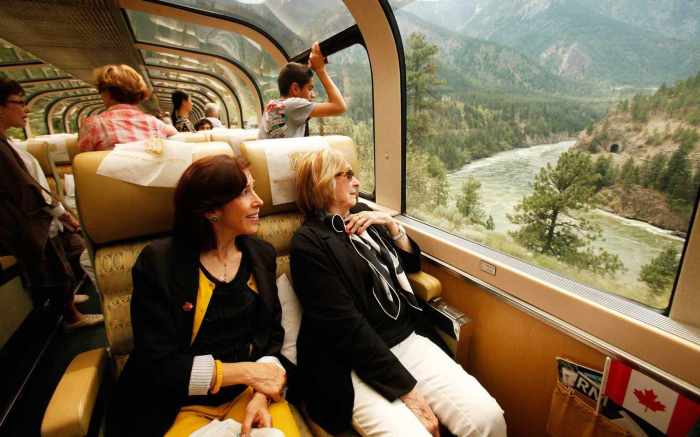Retirement Trips: The golden years beckon, promising a world of exploration and relaxation. But transforming that dream into a reality requires careful planning. This guide navigates the intricacies of crafting the perfect post-work adventure, from budgeting and destination selection to ensuring a safe and enriching experience. Whether you envision a luxurious cruise, a budget-friendly backpacking trip, or a relaxing beach getaway, we’ll equip you with the knowledge and strategies to make your retirement travels unforgettable.
We delve into the crucial aspects of retirement travel planning, addressing key considerations such as budget allocation, destination choices tailored to individual preferences, and the importance of health and safety. We’ll provide practical advice on managing expenses, selecting suitable accommodations, and maximizing your travel experiences while mitigating potential risks. From detailed itineraries and sample budgets to expert tips on photography and journaling, this comprehensive guide empowers you to create a retirement travel plan that aligns seamlessly with your vision.
Budgeting for Retirement Travel
Planning your retirement travel budget requires careful consideration of your desired travel style and financial resources. A well-structured budget ensures a memorable experience without jeopardizing your financial security. This section explores different budgeting approaches and strategies for maximizing your travel dollars.
Travel Budget Styles: Luxury, Mid-Range, and Budget
Retirement travel budgets can be categorized into three main styles: luxury, mid-range, and budget. Luxury travel prioritizes high-end accommodations, premium transportation, and exclusive experiences, often incurring significantly higher costs. Mid-range travel offers a balance between comfort and affordability, providing a comfortable experience without excessive extravagance. Budget travel focuses on maximizing value and minimizing expenses, often involving more economical accommodations and transportation options.
The choice depends on individual preferences and financial capabilities. For example, a luxury trip to Southeast Asia might involve private villas, chauffeured services, and Michelin-starred dining, while a budget trip could focus on hostels, local buses, and street food. A mid-range option could involve comfortable hotels, occasional taxis, and a mix of local and tourist restaurants.
Strategies for Saving Money on Flights, Accommodation, and Activities
Several strategies can significantly reduce travel expenses. For flights, booking in advance, being flexible with travel dates, and considering budget airlines can yield substantial savings. Websites comparing flight prices across different airlines are invaluable tools. For accommodation, exploring options beyond hotels, such as Airbnb or guesthouses, often provides more affordable and locally immersive experiences. Booking directly with the accommodation provider can sometimes avoid third-party booking fees.
Regarding activities, free or low-cost options such as walking tours, visiting local markets, and exploring parks and beaches are readily available in many destinations. Taking advantage of free activities and opting for less expensive alternatives can drastically reduce the overall budget.
Advantages and Disadvantages of Travel Reward Programs
Travel reward programs, offered by airlines and credit card companies, offer potential benefits but also have drawbacks. Advantages include accumulating points or miles that can be redeemed for flights, hotel stays, or other travel-related expenses. Strategic use of these programs can significantly reduce travel costs. However, disadvantages include the potential for high interest rates on credit cards if balances are not paid in full, and the complexity of program rules and restrictions.
Redeeming rewards might require flexibility in travel dates and destinations. Careful consideration of the program’s terms and conditions is crucial before enrolling.
Sample Budget Spreadsheet for a Two-Week Trip to Southeast Asia
The following is a sample budget spreadsheet for a two-week trip to Southeast Asia, assuming a mid-range travel style. These figures are estimates and can vary based on specific choices and destinations within Southeast Asia.
| Expense Category | Estimated Cost (USD) |
|---|---|
| Flights (round-trip) | 1,200 |
| Accommodation (14 nights) | 700 |
| Food (14 days) | 560 |
| Activities and Entrance Fees | 350 |
| Transportation (local) | 210 |
| Visas and Travel Insurance | 140 |
| Miscellaneous Expenses | 140 |
| Total Estimated Cost | 3,300 |
Note: This budget is an approximation. Actual costs may vary depending on the specific locations visited, travel style, and individual spending habits. Prices are subject to seasonal fluctuations and currency exchange rates.
Transportation Options for Retirement Trips

Planning transportation for retirement travel requires careful consideration of various factors, including budget, health, and desired travel style. Retirees have diverse needs and preferences, making the selection of appropriate transport crucial for a comfortable and enjoyable experience. This section analyzes different modes of transportation, highlighting their respective advantages and disadvantages to aid in informed decision-making.
Air Travel for Retirees
Air travel offers speed and efficiency, especially for long distances. However, navigating airports can be challenging for some retirees, particularly those with mobility limitations. Airlines often offer assistance programs for passengers with disabilities, but advance booking is essential. The cost of airfare can also be a significant factor, particularly for frequent travelers or those traveling internationally. Budget airlines may offer cheaper tickets, but often compromise on comfort and legroom.
Conversely, premium airlines provide more space, better service, and sometimes include perks that can enhance the overall travel experience for older travelers. The physical demands of air travel, such as navigating baggage claim and potentially long layovers, should be carefully considered.
Train Travel for Retirees
Train travel provides a more relaxed and scenic alternative to air travel. The ability to walk around and enjoy the views can be beneficial for retirees’ health. Train stations are often more accessible than airports, with better signage and assistance services available. However, train journeys typically take longer than flights, and the availability of train routes may be limited compared to air travel.
Costs can vary depending on the distance and class of travel, but are often competitive with air travel, especially for shorter distances. The potential for delays should also be considered.
Cruise Travel for Retirees
Cruises offer an all-inclusive travel experience, with accommodation, meals, and entertainment included in the price. This can be particularly appealing to retirees who prefer a hassle-free travel experience. However, cruises can be expensive, and the confined environment may not suit everyone. Accessibility on cruise ships varies, and it is essential to check the accessibility features before booking.
Seasickness is also a potential concern for some passengers. The itineraries are pre-determined, limiting flexibility for independent exploration.
Car Travel for Retirees
Driving oneself offers the greatest flexibility and control over travel plans. However, it can be tiring, especially on long journeys, and may not be suitable for all retirees. Consideration should be given to the physical demands of driving, including long periods of sitting and potential fatigue. Road trips also involve planning accommodation and meals along the route.
Car rentals can offer a compromise, allowing for flexibility without the demands of owning and maintaining a vehicle for the trip. However, costs must factor in fuel, tolls, and potential rental insurance.
Ride-Sharing and Public Transportation for Retirees
Ride-sharing services like Uber and Lyft offer convenient and affordable transportation options, especially in urban areas. However, accessibility features may vary, and the cost can fluctuate depending on demand. Public transportation, such as buses and subways, is generally more affordable than ride-sharing, but can be less convenient and potentially inaccessible to those with mobility issues. The reliability of public transportation also varies depending on location and time of day.
Careful consideration of routes, schedules, and accessibility features is essential.
Accessibility Considerations for Retirement Transportation
Choosing transportation that caters to accessibility needs is paramount. This includes considering factors such as wheelchair accessibility, assistance with boarding and disembarking, and the availability of accessible restrooms and seating. Many transportation providers offer assistance programs, but it’s crucial to book in advance and clearly communicate any specific needs. Prior research and communication are key to ensuring a smooth and comfortable travel experience for retirees with disabilities.
Tips for Navigating Transportation Hubs
Prior to departure, thoroughly research airport or train station layouts, identifying accessible routes and amenities. Allow ample time for travel to and from the transportation hub, and for navigating security checkpoints or boarding procedures. Consider using airport lounges or other waiting areas to rest and recharge. Pack light to minimize the strain of carrying luggage. Familiarize yourself with any assistance programs offered by the transportation provider and utilize them if needed.
Communicate your needs clearly and politely to staff members.
Capturing Memories

Retirement travel offers a unique opportunity for self-discovery and the creation of lasting memories. Documenting these experiences effectively ensures that the joy and wonder of your journey remain vivid for years to come. Combining high-quality photography with thoughtful journaling provides a rich tapestry of recollection, far surpassing the fleeting impressions of a simple vacation snapshot.High-quality photographs and detailed journaling are key to preserving the essence of your retirement travels.
Mastering a few basic photographic techniques and committing to regular journaling can transform your travel memories into a treasured heirloom. The act of actively documenting your experiences enhances your engagement with the journey itself, creating a deeper and more meaningful connection to the places you visit and the people you meet.
Techniques for High-Quality Travel Photography, Retirement Trips
Achieving professional-looking travel photos requires more than just pointing and shooting. Understanding basic composition principles, such as the rule of thirds (placing your subject off-center for a more dynamic image), and utilizing natural light effectively are crucial. Experiment with different angles and perspectives to capture unique viewpoints. For instance, instead of photographing a landmark from eye level, try shooting from a lower angle to emphasize its grandeur, or from a higher vantage point to showcase its surroundings.
Remember to pay attention to the background – a cluttered background can detract from your subject. Post-processing software can enhance your images, but strong composition and good lighting in the original shot are paramount.
The Benefits of Travel Journaling
A travel journal goes beyond simply recording daily itineraries. It’s a space for personal reflection, capturing not just the “what” of your journey but the “how” and “why” it impacted you. Detailed descriptions of sights, smells, and sounds, alongside personal anecdotes and emotions, create a rich and layered account of your experience. For example, describing the vibrant colors of a bustling market, the aroma of freshly brewed coffee in a Parisian cafe, or the feeling of awe standing before a majestic mountain range adds depth and texture to your memories.
The act of writing itself helps solidify these memories, transforming fleeting impressions into lasting recollections. Furthermore, journaling can be therapeutic, providing a space to process emotions and reflect on personal growth during your travels.
Creative Ways to Display and Share Travel Photos and Journals
There are numerous creative ways to showcase your travel memories. Consider creating a photo album with handwritten captions, incorporating journal entries alongside images to create a holistic narrative. Alternatively, a beautifully designed scrapbook, perhaps incorporating ticket stubs, postcards, and other mementos, can serve as a unique and personalized keepsake. Digital options include creating a slideshow with music or designing a personalized website or blog to share your experiences with friends and family.
For a more interactive approach, consider compiling your photos and journal entries into a travelogue-style book, suitable for self-publication or sharing digitally.
Essential Photography Equipment for Retirement Trips
A comprehensive kit doesn’t require professional-grade equipment. A high-quality digital camera with interchangeable lenses is ideal, allowing for flexibility in different shooting situations. A versatile zoom lens (e.g., 24-70mm) is highly recommended, covering a wide range of focal lengths. A tripod is essential for sharp images in low-light conditions or when shooting panoramas. Consider a portable external hard drive for storing your photos and a reliable memory card reader to facilitate easy transfer to your computer.
Don’t forget spare batteries and memory cards to avoid missed opportunities. Finally, a small, lightweight cleaning kit can help maintain the quality of your lenses.
Planning your retirement trip is an exciting journey in itself, a chance to dream big and create lasting memories. By carefully considering your budget, choosing destinations that resonate with your interests, and prioritizing safety and well-being, you can ensure a truly fulfilling and enriching experience. Remember, the perfect retirement trip is the one that aligns perfectly with your personal aspirations and allows you to savor every moment of this well-deserved chapter of your life.
So start planning, embrace the adventure, and create a retirement journey that you’ll cherish for years to come.

